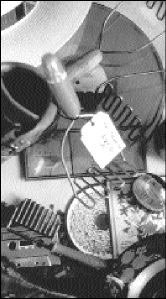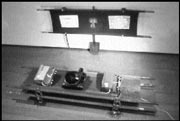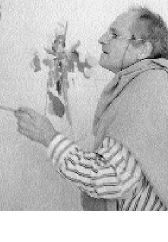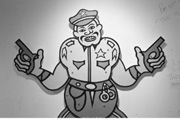ON A SATURDAY afternoon last month, a smattering of art-heads and starving artists were gathered in a warehouse-style pavilion to hear the Seattle Art Museum’s new curator, Lisa Corrin, holding forth in dramatic style. On makeshift walls were over 200 local works of art slated to be auctioned off to benefit the nonprofit Artist Trust. Each year, the day before the auction and champagne brunch, local curators give a free informal talk about the donated work.
“This is sort of my coming-out party,” joked Corrin, who was hired last September but has kept a low profile. She was being sized up, and she knew it.
As she ambled through the gallery pausing at works that caught her eye, she seemed eager to vaunt her intellectual prowess, linking each piece she encountered to a larger movement or big-name contemporary artist—even if the connection was a bit of a stretch. As she studied C. Blake Haygood’s print of a fantastical contraption, she asked the crowd, “Do you know Chris Burden’s work?” She proceeded to go on and on—with a pronounced Long Island accent oddly touched with British inflection—about Burden’s installations and an ambitious commission he did for the Tate Gallery in London.
Corrin managed to win over the crowd with her humor and warmth, pulling artists into the discussion, clutching their arms affectionately. But after she’d led the shuffling group from one corner of the gallery to another, the whisper on most everyone’s lips was: “Did you see her shoes?”
The shoes—little black numbers with fluted, flared heels and pointy, upturned toes—were weirdly out of sync with Corrin’s matronly black dress, and the whole ensemble seemed a perfect embodiment of the challenge Corrin faces at SAM. As she put it a few weeks later in an interview: “OK, we’re authoritative, we’re the museum in this area. But . . . we want to prove we’re neither dowdy nor exclusive.”
PERCHED ON an enormous rocking chair in her office, Corrin leaned toward me and asked rhetorically, “How do we show the community that the Seattle Art Museum isn’t some moribund thing?” She might just be the dynamo to lead SAM into a new era and revamp its image as a warehouse for big, glitzy, and ultrasafe traveling shows. “SAM needed someone who had a way of giving voice to their aspirations,” she said, explaining her move from London’s Serpentine Gallery. “I’m the professional they brought in to do that.”
Corrin’s been busy since her arrival drafting a new vision and mission statement to be released this year as part of a major branding campaign. “I’m trying to make changes here that are really quite sweeping. I mean they’re huge. The specific exhibitions are only the symptom, the concrete manifestation of the more profound philosophical reorientation going on inside this building.”
Part of this reorientation will include a more postmodern, Fred Wilson-style approach to exhibition making. Look for attempts to soften the museum’s authoritative voice with more shows like Pam McClusky’s “Art of Africa” (currently on view), which brings African scholars and artists in as collaborating curators and presents objects in their cultural context by showing them alongside videos, presentations, and performances.
“The separation between anthropology and art that has always characterized us is going to be broken down,” Corrin says. “I’m bringing Native American art and aboriginal art to the fourth floor, where we normally only show modern and contemporary stuff. Why? Because these are contemporary artists.”
A quick glance at the exhibition schedule for the next few years doesn’t immediately reveal any fundamental changes in direction for SAM, aside from an obvious swing toward pointed multiculturalism that, while noble, somehow seems old-fashioned. Many of the changes aren’t conspicuous at all, but a new approach requiring the viewer’s attentive engagement throughout the museum aims to cast even the most universally embraced work in a more critical light.
Next spring, for instance, while the famous Lansdowne portrait of George Washington by Gilbert Stuart graces the gallery walls, a contrasting exhibition will be on view called “Hero/Anti-Hero.” “We have a very patriotic painting coming, the father of our country, the namesake of our state,” Corrin smiles wryly, “but we’re not just going to take that sitting down . . . because we know that First Nations aren’t going to exactly agree he’s a hero. We’re going to have an opportunity to really look at that critically, respectfully, but across the entire institution.
“I problematize everything,” Corrin says proudly, “because I think exhibition making is a rhetorical act. It’s about making an argument. It’s not about decorating the living room.”
Corrin’s self-declared old-school feminist tendencies manifest themselves in an interconnectedness that is to permeate the building. “There’s a conceptual density around the thinking,” she explains. “It’s holistic. Everything is connected to everything else.”
For example, “We’ve got Impressionism this summer,” she says almost apologetically with a dismissive wave of her hand. “But then picture this: We’ve got the whole museum devoted to Mexican art and culture.”
As for her new city, Corrin exclaims, “I love it! I came here because Seattle is still a city in the process of becoming. It’s not so fixed. Here, a person with vision, who gains credibility over time . . . can change a city, not just a museum.”








